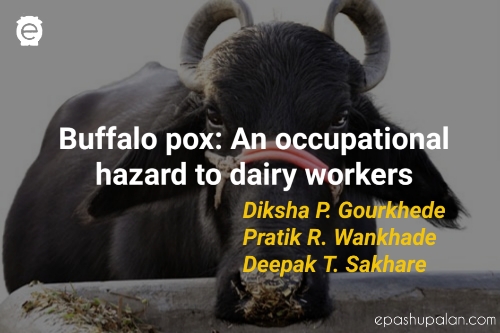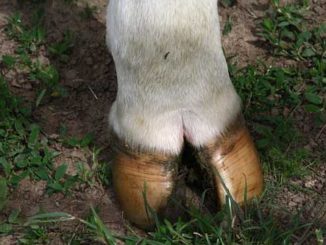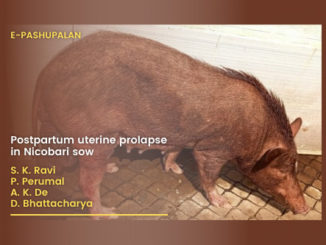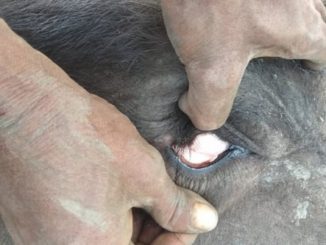Introduction
Buffalo pox is a highly contagious zoonotic viral disease. It is reported to be an emerging and re-emerging disease affecting large herd population across India. The main host for this disease is Domestic buffaloes (Bubalus bubalis) also affecting cows and human beings. Buffaloes of all age groups and both sexes are affected however, it is more severe in young and old animals. The etiological agent is the buffalopox virus, genus orthopox in the family poxviridae. This disease is naturally transmitted in buffalo herd. In humans the attendants and milkmen who are in close proximity with affected buffaloes are usually get infected. As it is zoonotic infection, milk attendants can spread the virus between buffalo and from buffalo to cows. The infection causes economic impact due to reduced milk yield in dairy animal and reduced working capacity in draft animals. This disease is endemic with increasing trend in India. The first case of buffalo pox has recorded in year 1934. Buffalo pox mainly have two clinical form i.e. mild and severe form of disease in animals. In mild form local lesions confined to the inguinal region, udder and teats, above parotid gland, inner aspect and base of eyes and ear are seen whereas, in severe form generalized lesions seen on seen on the teats, udder, thighs and hindquarters of infected animals. Generalized infection can leads to mastitis in dairy animals affecting milk production and leading to huge economic loss to dairy farmers.

Occupation hazard to dairy workers
1. Zoonotic transmission to dairy worker
Recently several zoonotic outbreaks of this disease have occurred in many parts of India. Dairy workers who are in close contact with animals generally get infected. Animal attendant and milkers are at high risk of getting infection from infected animals. Buffalo pox is mainly spread to worker during various farm practices like milking, washing and watering etc. Main relief is that buffalo pox transmissions between humans are not been documented yet.
2. Clinical manifestation in dairy worker:
- The incubation period of buffalo pox in dairy worker is generally 3-19 days after they get expose to infected animal.
- Males and females have equal chance of getting infection i.e. there is no difference in severity of disease in worker.
- All age group of dairy workers can get infection.
- The clinical signs observed like fever (39.-40.5°C) for 2-3 days followed by skin lesions like small round nodules with umbilication with an erythematous base.
- Lesion may contain pus with cheese like appearance.
- The size of the pustules vary from 1-2 mm to 1 cm in diameter.
- The severity of may persist up to 7-8 days.
- Grossly the lesion mainly observed on face, forehead, hands, buttocks and legs with lymphadenopathy of dependent parts.
|
Table. There are few sporadic cases reported in India. Recent outbreaks are mentioned here. |
||||
|
Area-Village/ State |
Year |
Number of Human cases |
Identification/ confirmation test |
References |
| Aurangabad, Maharashtra |
2003 |
– |
CIE, SNT, PCR and Virus isolation | Singh et al., 2006 |
| Tamil Nadu |
2005-06 |
– |
– | Singh et al., 2012 |
| Kolhapur- Pune, Maharashtra |
2009 |
125 |
CIE, SNT, PCR, TaqMan PCR | Venkatesan et al., 2010 |
| Thotapalligudur- Nellore, Andra Pradesh |
2006-08 |
7 |
CIE, SNT | Bhanuprakash et al., 2010a |
| Aurangabad (Kathiawad region) |
2006-08 |
5 |
CIE, PCR, Real time PCR, Virus isolation | Bhanuprakash et al., 2010b |
| Aundh – Pune, Maharashtra |
2006-08 |
4 |
SNT | Bhanuprakash et al., 2010b |
| Ratadia – Sardar Krishinagar, Gujarat |
2006-08 |
9 |
CIE | Bhanuprakash et al., 2010b |
| Bavar – Sardar Krishinagar, Gujarat |
2006-08 |
11 |
CIE | Bhanuprakash et al., 2010b |
| Hisar, Haryana |
2014 |
1 Laboratory Acquired |
PCR | Riyesh et al., 2014 |
Diagnosis of Buffalo pox
Mainly clinical diagnosis is done on the basis of typical pox lesion on affected body part. However, there are several diagnostic methods available like;
- Virus isolation: using embryonated chicken eggs, primary cell culture and cell lines
- Serological tests: Agar gel immunodiffusion test (AGID), Serum neutralization test (SNT), Counter-immunoelectrophoresis (CIE), Immunoperoxidase test (IPT) and ELISA
- Molecular Diagnostic Tests: PCR based on HA genes have been used for diagnosis and differentiation of OPVs.
Preventive measures for dairy workers
To prevent infection in dairy workers we need to focus on its prevention in animals. Sporadic buffalo pox incidence has to control in animal herd which is an effective way to restrict infection in workers. Vaccination is the most economical and effective method to control any infection. Many of the vaccine trials are going on to prevent buffalo pox. However, no vaccine for commercial use is available till now. In the absence of appropriate immune-prophylactic measures, movement control of animals, implementation of hygienic measures like isolation of the diseased animals is only method to control the spread of infection. Sanitary measures should be followed in dairy farm to restrict the spread of the infection. The milkers should wash hands with soap solution before and after milking. Clean milk production practices should be strictly followed. Workers may use gloves while milking, this will help to avoid spread of infection from infected buffalo to uninfected one or to workers. Recently, autoimmunization technique is used for the prevention from buffalo pox disease. The immunization is done by injecting blood collected through jugular vein from infected animals to healthy animals. The blood is injected on thigh muscles 5 mL on each side.
Conclusion
Taken together, considering the hazardous effect of this zoonotic disease. Hygienic and sanitary practices should be followed by the dairy workers. The susceptible group of animals should be vaccinated on timely basis. Clean milk production practices should be encouraged.
References: These will be provided on request to the authors. (Kindly request in comment section below)
|
The content of the articles are accurate and true to the best of the author’s knowledge. It is not meant to substitute for diagnosis, prognosis, treatment, prescription, or formal and individualized advice from a veterinary medical professional. Animals exhibiting signs and symptoms of distress should be seen by a veterinarian immediately. |








Be the first to comment